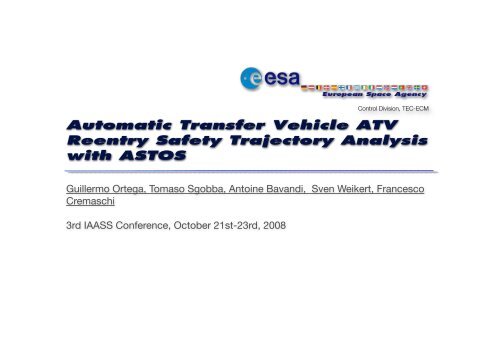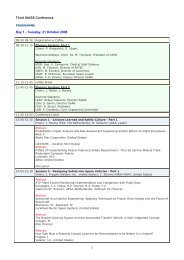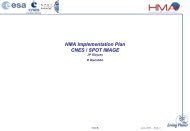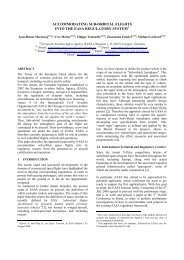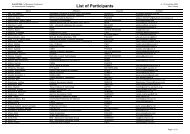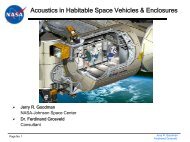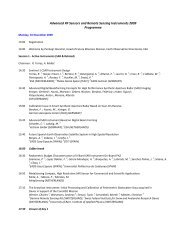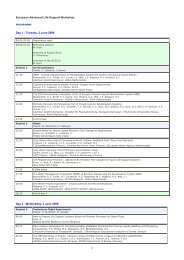Automatic Transfer Vehicle ATV Reentry Safety Trajectory ... - Congrex
Automatic Transfer Vehicle ATV Reentry Safety Trajectory ... - Congrex
Automatic Transfer Vehicle ATV Reentry Safety Trajectory ... - Congrex
Create successful ePaper yourself
Turn your PDF publications into a flip-book with our unique Google optimized e-Paper software.
Control Division, TEC-ECM<br />
<strong>Automatic</strong> <strong>Transfer</strong> <strong>Vehicle</strong> <strong>ATV</strong><br />
<strong>Reentry</strong> <strong>Safety</strong> <strong>Trajectory</strong> Analysis<br />
with ASTOS<br />
Guillermo Ortega, Tomaso Sgobba, Antoine Bavandi, Sven Weikert, Francesco<br />
Cremaschi<br />
3rd IAASS Conference, October 21st-23rd, 2008
Presentation guide<br />
<strong>ATV</strong> and <strong>ATV</strong> re-entry<br />
<strong>Trajectory</strong> re-entry safety analysis<br />
ASTOS a re-entry tool<br />
Way Forward<br />
Conclusions<br />
2
Time-line of <strong>ATV</strong> re-entry analysis<br />
ESA-CNES task force on <strong>ATV</strong> re-entry safety ends April<br />
2007: risk analysis starts<br />
Mission analysis update in Autumn 2007<br />
Re-entry safety analysis ends February 2008<br />
<strong>Safety</strong> analyses of controlled and uncontrolled reentry<br />
trajectories as well as the calculation of<br />
debris survivability and the estimation of risk<br />
probability<br />
Re-entry scheduled for Autumn 2008<br />
3
<strong>ATV</strong><br />
<strong>Automatic</strong> <strong>Transfer</strong> <strong>Vehicle</strong><br />
build by EADS for ESA<br />
Operated by CNES<br />
Used to resupply ISS and<br />
raise its apogee<br />
Launched by Ariane-5<br />
<strong>Automatic</strong> not autonomous<br />
Named “Jules Verne”<br />
4
<strong>ATV</strong> Re-entry scenario: CNES mission analysis<br />
2nd ORBIT<br />
ΔV1<br />
ΔV2<br />
DEPARTURE FROM<br />
ISS ORBIT<br />
1st ORBIT<br />
5
Risk assessment: roles and responsibilities, ESTEC part only<br />
<strong>ATV</strong> <strong>Reentry</strong><br />
<strong>Safety</strong><br />
Review<br />
Panel<br />
(RSRP)<br />
Request for<br />
analysis<br />
<strong>ATV</strong> Ground<br />
segment ESA<br />
ESA’s Technical<br />
Directorate TEC<br />
<strong>ATV</strong> Project<br />
manager<br />
Request for<br />
analysis<br />
<strong>ATV</strong> Ground<br />
segment<br />
CNES<br />
6
ESTEC Analysis<br />
Assess <strong>ATV</strong> disposal cargo list w.r.t. their contribution to the surviving<br />
fragments list in the case of an uncontrolled re-entry<br />
Compute trajectories and their corresponding casualty and fatality<br />
probability:<br />
controlled re-entry with explosion without demise<br />
controlled re-entry with explosion with demise<br />
controlled re-entry without explosion with demise<br />
uncontrolled re-entry with explosion with demise<br />
uncontrolled re-entry without explosion with demise<br />
7
Failure Cases Considered<br />
[300;300] ORBIT, 100% FUEL LOAD<br />
[460;460] ORBIT, 10% FUEL LOAD (NOMINAL)<br />
UNREALISTIC FAILURES<br />
8
Nominal Re-entry <strong>Trajectory</strong> by CNES<br />
10-2<br />
FOOTPRINT<br />
10-5<br />
FOOTPRINT<br />
SPOUA<br />
9
<strong>ATV</strong> re-entry<br />
10
<strong>ATV</strong> interior view<br />
Composed of 2<br />
main parts:<br />
Spacecraft<br />
subassembly<br />
Integrated cargo<br />
carrier<br />
4 solar arrays<br />
skewed about 45<br />
deg<br />
a S-band antenna<br />
mast mounted<br />
11
<strong>ATV</strong> rear 3D view<br />
Main propulsion system composed<br />
of a set of thrusters<br />
12
<strong>ATV</strong> front 3D view<br />
Composed of the docking<br />
mechanism<br />
Attitude control thrusters<br />
Rendezvous sensing system<br />
13
Size comparison<br />
14
<strong>ATV</strong> model 3D views<br />
15
<strong>ATV</strong> Docking Mechanism<br />
16
ASTOS: AeroSpace <strong>Trajectory</strong> Optimization Software<br />
ASTOS is an<br />
optimization<br />
environment to<br />
compute optimal<br />
trajectories<br />
(launchers reentry)<br />
Use Non-Linear<br />
Programming<br />
(NLP)<br />
mathematical<br />
solvers<br />
Developed in<br />
WinXP, Solaris,<br />
Linux, MAC OS X<br />
17
Inputs to safety analysis<br />
Initial boundary constraints<br />
Path constraints<br />
Orbital<br />
constraints<br />
Path constraints<br />
<strong>Vehicle</strong> features<br />
Planetary<br />
environment<br />
conditions<br />
Final boundary constraints<br />
18
<strong>Trajectory</strong> <strong>Safety</strong> Analysis: HOWTO<br />
Input data<br />
Entry Analysis <strong>Safety</strong> Analysis<br />
ASTOS<br />
Risk Assessment Analysis<br />
RAM<br />
DARS, DIA<br />
19
DARS, DIA, and RAM modules<br />
2D, 3D Visualization<br />
and Reporting<br />
ASTOS<br />
RAM<br />
DARS DIA<br />
DARS (Debris Analysis Re-entry Spacecraft) calculates the stage re-entry considering break-up<br />
and demise<br />
DIA (Debris Impact Analysis) calculates the impact based on ballistic coefficients<br />
RAM (Risk Analysis Module) calculates the risk probabilities of human casualties and fatalities<br />
20
DARS, DIA, RAM modules of ASTOS<br />
DIA is based on<br />
ballistic coefficients<br />
and allows safety<br />
analysis in combination<br />
with additional<br />
impulses during the<br />
break-up already in<br />
early project phases<br />
RAM is used to<br />
compute the risk to the<br />
population on-ground<br />
DARS, DIA, RAM are<br />
modules of ASTOS<br />
and are fully integrated<br />
in the ASTOS GUI<br />
21
RAM (Risk Analysis Module for ASTOS)<br />
RAM calculates the casualty cross-section (Ccs) of a re-entry<br />
object<br />
Ccc is computed using the the cross-section of all surviving<br />
objects and an average projected cross section of a human<br />
body<br />
The probability of casualty is determined using this casualty<br />
cross-section, the impact probability, and a population density<br />
distribution map<br />
The risk to the population on-ground is determined by<br />
integrating the probability over a terrain area with underlying<br />
population density<br />
Plots in 2D and 3D are available<br />
22
<strong>ATV</strong> cargo list used for ESTEC analysis<br />
23
ECM <strong>Trajectory</strong> Risk Analysis<br />
Parameter Distribution Dispersion<br />
Impulse duration Gaussian Mean=1383.4 s, 3sigma = 35%<br />
Thrust level Uniform [-5.4% ; 13.2%]<br />
Thrust pitch angle Gaussian 3sigma = 1.72°<br />
Atmosphere density Uniform [-50% ; 50%]<br />
Altitude of explosion Gaussian mean=75 km, 3sigma=6km<br />
Fragments ejection direction Uniform uniform dispersion in 3D space<br />
21x10 6 trajectories run<br />
First deorbitation maneuver is not<br />
dispersed<br />
ASTOS’s bach mode tool used to<br />
perform the Monte Carlo simulations<br />
24
Footprint with Demise<br />
25
Footprint without Demise<br />
26
3D Projection of DARS results<br />
27
Risk Assessment Comparison: ESA/TEC - ACTA<br />
Initial ESA/TEC Risk<br />
Assessment<br />
ACTA Risk Assessment Updated ESA/TEC Risk<br />
Assessment<br />
November 2007 August 2008 September 2008<br />
- Descending re-entry track (expected<br />
trajectory)<br />
- initial mass of 20.1 t (expected mass)<br />
- 131 surviving fragments (60% of initial<br />
mass)<br />
- Explosion occurs at 75km altitude<br />
+/-2km at 1σ<br />
- Does not consider population sheltering<br />
- Fatality Kinetic Energy Threshold = 32J<br />
- Casualty Area ~ 108 m 2<br />
- Descending re-entry track (expected<br />
trajectory)<br />
- initial mass of 12.4 t (expected mass)<br />
- 214 surviving fragments (25% of initial<br />
mass)<br />
- Explosion at 78km altitude (nominal<br />
case, otherwise between [68 ; 84km])<br />
- Considers population sheltering<br />
- Fatality Kinetic Energy Threshold = 79J<br />
- Casualty Area ~ 205 m 2<br />
- Descending re-entry track (actual<br />
trajectory)<br />
- initial mass of 13.4 t (actual mass)<br />
- 214 surviving fragments from ACTA<br />
(25% of initial mass)<br />
- Explosion at 78km altitude (nominal<br />
case, otherwise between [68 ; 84km])<br />
- Does not consider population sheltering<br />
- Fatality Kinetic Energy Threshold = 32J<br />
- Casualty Area ~ 205 m 2<br />
P F = 2.0×10 -5 P F = 2.4×10 -5 P F = 4.1×10 -5<br />
28
Expected Fatality Probabilities comparison: ESA/TEC - ACTA<br />
Type of Scenario ESA/Technical<br />
Directorate<br />
(unsheltered)<br />
ACTA Inc.<br />
(sheltered)<br />
Controlled 0.8×10 -5 0.4×10 -5<br />
Uncontrolled 3.3×10 -5 2.0×10 -5<br />
Total 4,1×10 -5 2.4×10 -5<br />
US Requirement < 3.0×10 -5 < 3.0×10 -5<br />
29
Footprint comparison ASTOS-ACTA study<br />
The ASTOS footprint extensions are slightly smaller that in the<br />
ACTA study<br />
in the order of -25 km up-range and 3 Km down-range<br />
The fragments impacts are slightly more outspread<br />
in the order of +20 km up-range and 2 Km down-range<br />
CONCLUSION:<br />
For the nominal controlled scenarios studied in part 2,<br />
ASTOS simulations provide results (10-5 footprint) that<br />
are similar to the ACTA simulations with a variation of<br />
1.6 %<br />
30
Conclusions (I)<br />
First analysis risk assessment performed:<br />
good number of trajectories have been<br />
run with several parameters,<br />
configurations, etc<br />
The assumptions and input data have<br />
been checked with the project/CNES<br />
Analysis shows risk below NASA<br />
standards<br />
31
Conclusions (II)<br />
<strong>Trajectory</strong> risk analysis is not yet a common practice<br />
(even in a voluntary basis)<br />
The re-entry risk analysis process is composed of a<br />
series of steps (procedure) that comprises the use of<br />
software tools to calculate demise and fall down of<br />
debris<br />
The cost of the use (or even imposition in a space<br />
project) of these tools is minimal in comparison with<br />
the liability that would occur in case of disaster<br />
32


